In the histories of the Second World War, much has been made of the vaunted British and US Airborne forces, the latter being the protagonists of the legendary series Band of Brothers, a source of inspiration for Bolt Action players the world over. Far less, however, is said about their German counterparts, the Fallschirmjäger (literally ‘parachute light infantry/hunters) of the Luftwaffe. TV aficionados may recall these camouflage-smocked soldiers as among the defenders of Carentan in the aforementioned HBO show, fighting hard against the onrushing Allied assault. Let’s take a look at these hard-bitten men, and see how they can be used to great effect in games of Bolt Action!
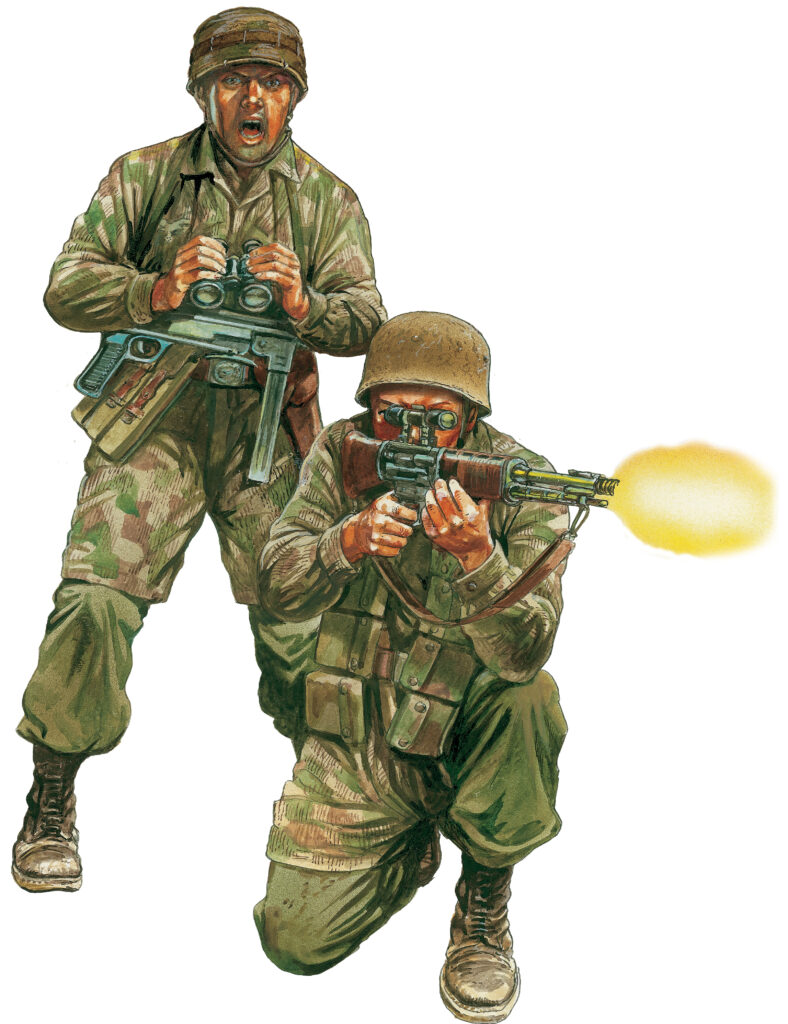
Impressed by the (admittedly rather crude) Soviet demonstrations of parachute infantry in the interwar period, commander of the Luftwaffe (German air force) Herman Göring ordered the formation of a paratroop unit in 1935, from a Prussian quasi-police unit he had set up several years previously. Interestingly, the Fallschirmjäger remained under the control of the Luftwaffe rather than the Heer (army), and were all air force personnel, something of a contrast to airborne troops in most other militaries. By 1938 a division was ready, and saw heavy use in the early stages of the war in its intended role, most famously at the capture of Fort Eben-Emael in Belgium, a significant fortification complex that would have required a long and costly operation to reduce using conventional methods. Employing the novel method of… simply landing right on top of the defenders, the fortress fell in a day. The Fallschirmjäger would go on to serve through the Low Countries, the Fall of France, and in North Africa.
The Battle of Crete saw the first and last mass combat drop for the Fallschirmjäger, who had up to this stage jumped primarily in small formations to take specific tactical objectives. Landing by parachute and glider, they ran into determined Commonwealth and Greek resistance, and suffered horrendous casualties. Their problems were compounded by the German practice of dropping weapons in separate canisters to the men (as opposed to the Allies, whose paratroopers dropped with their personal weapons), leaving the Fallschirmjäger armed only with pistols and knives available immediately on landing. Additionally, large numbers of the Junkers Ju-52 transport aircraft were destroyed, and although the invasion was a success, the loss of men and materiel convinced the German high command that airborne assaults were unfeasible in modern warfare – the Allies, meanwhile, took inspiration from the events for airborne forces of their own!
For the remainder of the war, the Fallschirmjäger would serve as traditional infantry, albeit benefitting from the intense training regime and somewhat preferential allocation of equipment granted by being part of the Luftwaffe supply system. The most famous piece of Fallschirmjäger equipment was the eponymous Fallschirmjägergewehr 1942 (parachutist’s rifle, model 1942), a highly-advanced assault rifle capable of laying down effective sustained fire, which would become synonymous with the men who used it. Equally famous were the Knochensack (literally ‘bone-sack’) camouflaged jump smock, and their brimless helmets (the iconic Stahlhelm being thoroughly unsuitable for jumping out of aeroplanes in!). All in all, they were an iconic-looking force, and a fantastic challenge for painters and modellers to really get their teeth into! On both the Eastern and Western fronts, the German parachutists fought doggedly against the Allied advance, living up to their nickname of “Green Devils”. As the war dragged on, and German losses mounted, the elite status and esprit de corps of the Fallschirmjäger force were slowly eroded. By mid-late 1944, most units were Fallschirmjäger in name only, with replacements and new formations stood up with re-tasked Luftwaffe ground crew or raw recruits with only the most basic training. In the most extreme cases in late 1944 and early 1945, the old men and young boys of the Volkssturm militia were being mobilised as replacement ‘Fallschirmjäger’ units, a far cry from the highly-trained and motivated paratroopers of only a few years previously.
While there are many theatres and actions for us to choose from when creating a Fallschirmjäger force for Bolt Action, for me the absolute classic has to be Carentan! Handily, the Campaign D-Day: US Sector book has both a bunch of new units to represent the Fallschirmjäger in Normandy, as well as the Lions of Carentan theatre selector, allowing us to create just such a force! Let’s take a look at what such an army might look like, how it plays, and how we can go about assembling it!
| Unit Type | Unit Name | Options | Cost |
|---|---|---|---|
| Infantry (Headquarters) | Fallschirmjäger Leutnant | Four Extra Men; Four Assault Rifles; | 122 |
| Infantry (Squad) | Fallschirmjäger Squad (Late-War) | Five Extra Men; Two LMGs; Two Panzerfausts; | 170 |
| Infantry (Squad) | Fallschirmjäger Squad (Late-War) | Five Extra Men; Ten Assault Rifles; Four Panzerfausts; Hedgerow Ambush; | 240 |
| Infantry (Squad) | Fallschirmjäger Pioneer Squad (Late War) | Flamethrower; Three Panzerfausts; | 98 |
| Infantry (Squad) | Osttruppen Squad | Five Extra Men; SMG; | 43 |
| Infantry (Squad) | Osttruppen Squad | Five Extra Men; | 40 |
| Infantry (Team) | Veteran Medium Machine Gun Team | Stubborn; Hedgerow Ambush; | 78 |
| Infantry (Team) | Veteran 75mm LG40 | Stubborn; Hedgerow Ambush; | 67 |
| Infantry (Team) | Veteran Sniper Team | Stubborn; | 67 |
| Infantry (Team) | Veteran Sniper Team | Stubborn; | 67 |
992 Points, 10 Order Dice
What we have here is a really interesting force with some really fun and thematic special rules, ideal for fighting in the hedgerows around Carentan and the built-up area of the town itself. Hedgerow Ambush allows the big Assault Rifle squad, recoilless rifle, and MMG team to set up using the Hidden rules along with the snipers, and deploy already on an Ambush order, meaning that as soon as an enemy turns up, they’re in for a world of hurt! With 10 Order Dice, it’s a little low on bag control, but certainly not bad for a nearly all-Veteran army – the Osttruppen providing some much-needed cheap bodies and representing the few battered Wehrmacht survivors in Carentan, and contrasting nicely with the hard as nails Fallschirmjäger! Tactically this list wants to get up close and personal with the Pioneers and the assault riflemen, while the LMG squad lays down covering fire, and snipers pick off weapons teams and officers. The primary downside is a lack of dedicated anti-tank firepower, although ten panzerfausts and a flamethrower still give the list plenty of close-range punch and should keep enemy armour on its toes! The best bit about it is it can be made from a single box of plastic Fallschirmjäger at its core, along with a couple of blisters, and a couple of Grenadier sprues for the Osttruppen, meaning it’s pretty economical to get it onto the tabletop.
Dig in, Fallschirmjäger! The Americans are coming, and they must not take Carentan before reinforcements arrive!
Other articles in the Forces of Fame Series:
Bolt Action – The Tiger I; Princess Elizabeth (Jubilee Special); Japanese Special Naval Landing Force; M18 Hellcat; Centurion Mk III; British Airborne; M4A3E8 Sherman ‘Easy Eight’;
Blood Red Skies – Messerschmitt Bf 110; Ki-43 II ‘Oscar’; Grumman F9F Panther;
Victory at Sea – The Bismarck; Fletcher-Class Destroyers; Kongō;
Pike & Shotte (& Pike & Shotte Epic Battles) – Cuirassiers; Polish Winged Hussars; Dragoons;
Black Powder (& Black Powder Epic Battles) – The Iron Brigade; 95th Rifles;
Black Seas – HMS Victory;
Hail Caesar / SPQR – Dacian Falxmen; Hoplites;
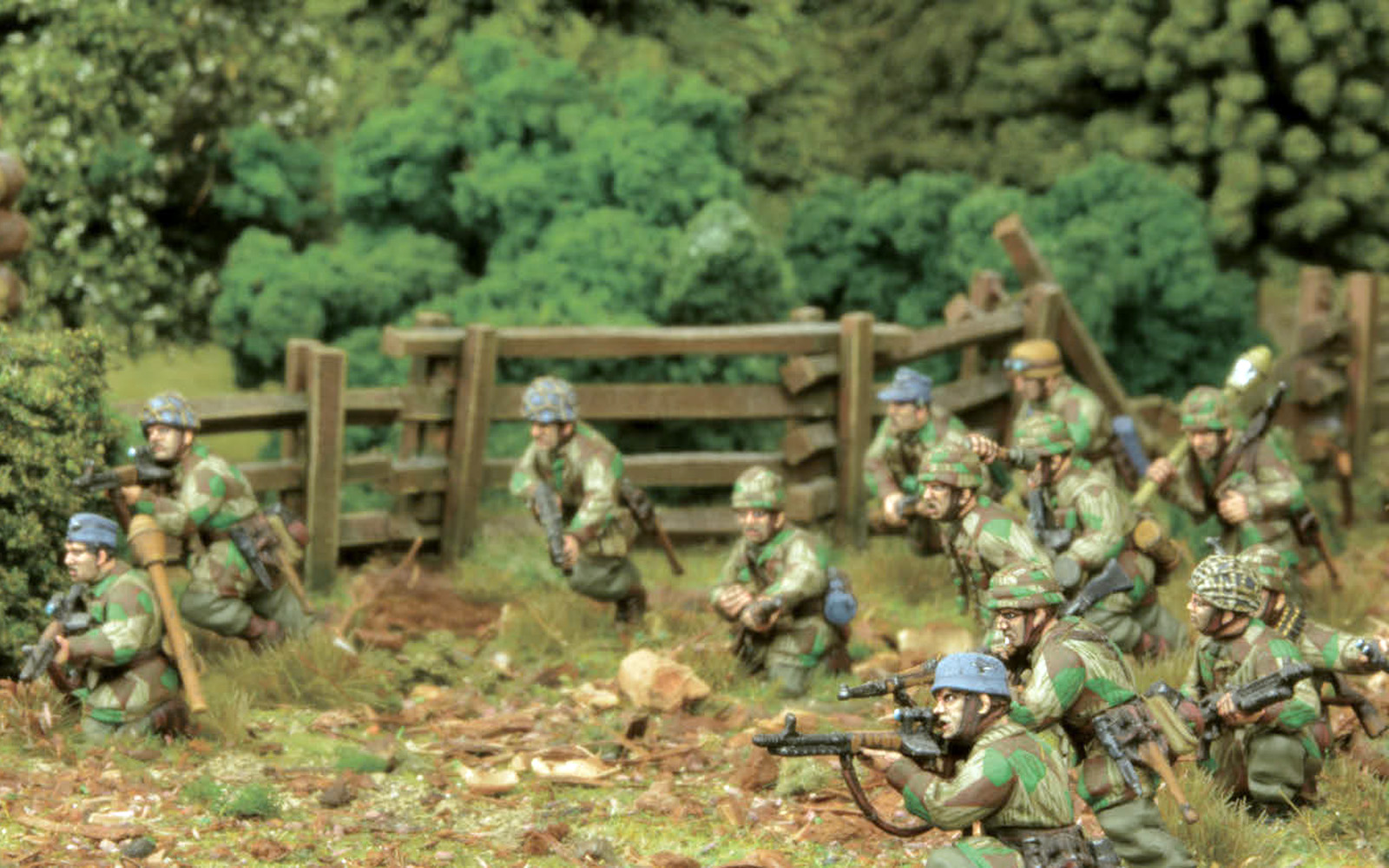
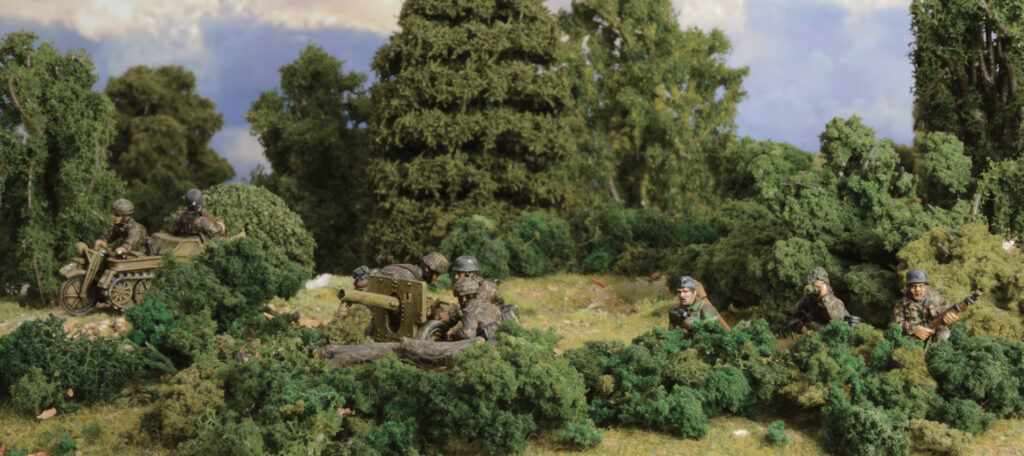
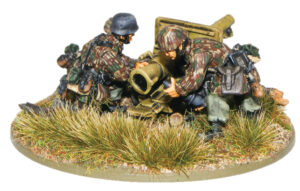
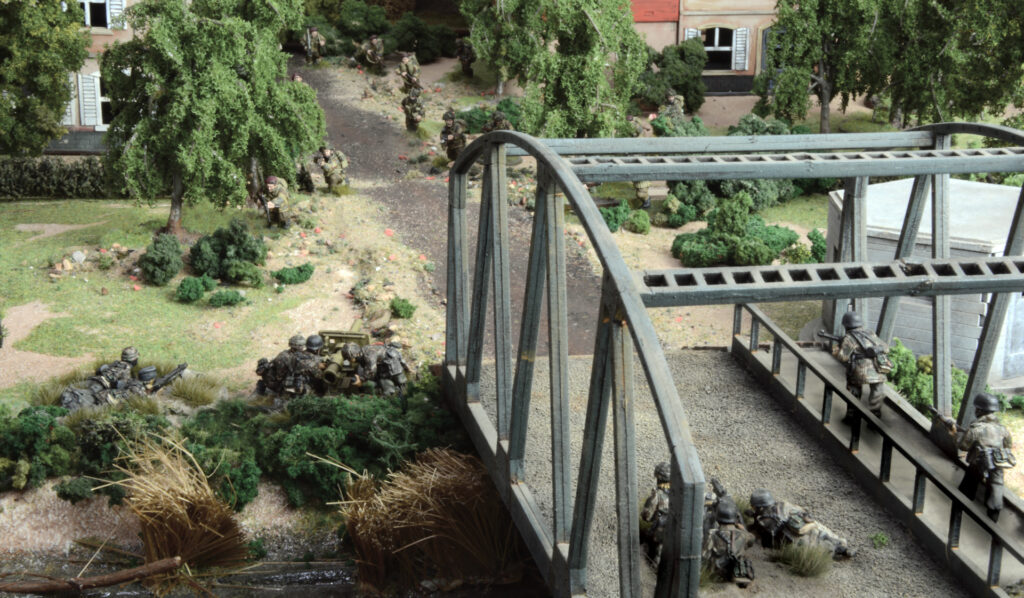
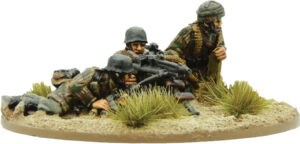
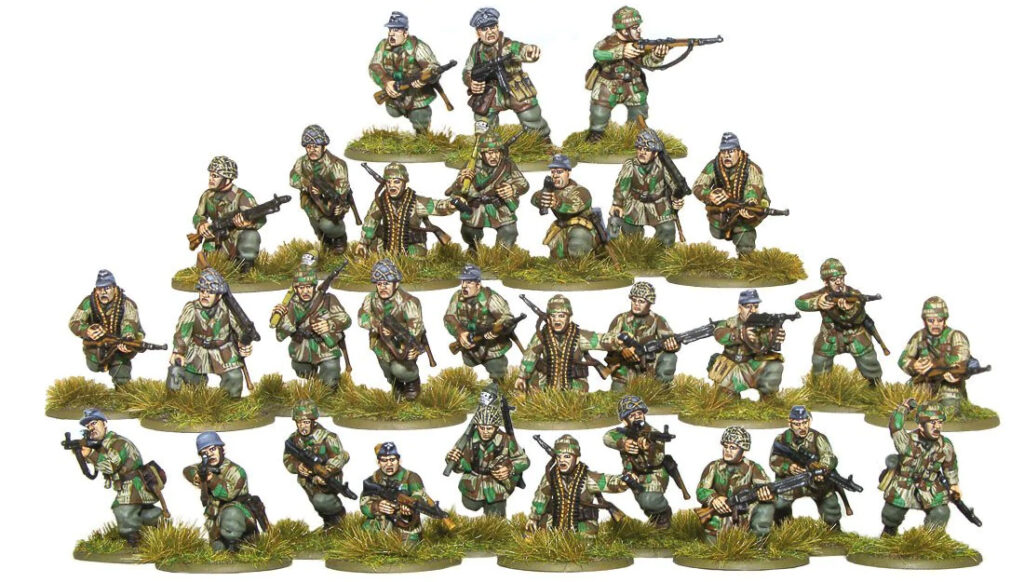
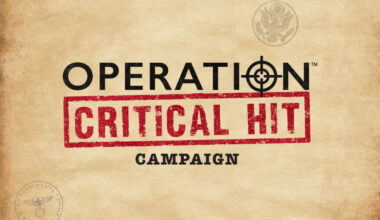
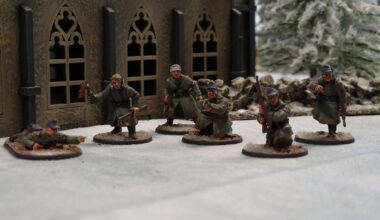
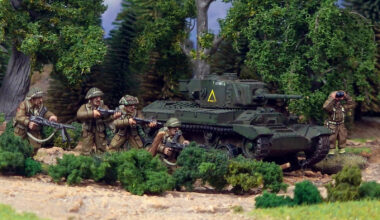
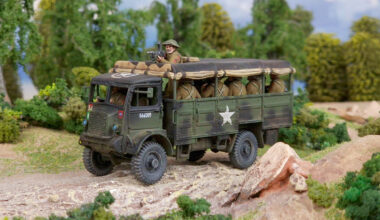
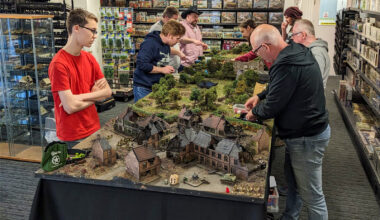
5 comments
I may well be incorrect but I thought the stubborn rule only applies to squads, not to team weapons? So the sniper teams, for instance, should be costed at 65 points and not have stubborn? Also your squads don’t have stubborn but I believe it’s obligatory. At least, Easy Army is telling me all this (I don’t have the Campaign D-Day: US Sector book. Can you please verify either way?
Campaign D Day US sector says all Fallschirmjager infantry and artillery must be veteran and upgraded to stubborn at a cost of 1 point per model. I suspect it hasn’t been listed on the squads above as it’s not an option or extra as they get it as standard. Just the sniper and LG70 team that has to pay for the privilege.
I notice the picture of the howitzer is the LG70/1 105mm not the 75mm as captioned.
Oops. Well caught. Edited!
The Germans only decided that large scale airborne operations were not feasible after the capture of Crete. Germany conducted at least 20 airborne (air-landing and parachute) operations after Crete, of which 14 were successful. The operations varied from a single platoon of Brandenburgers to multiple Fallschirmjäger battalions. The average size of these operations overall was approximately 760 men each. Germany continued to use airborne operations to seize specific objectives or quickly reinforce ground forces in threatened areas unril December, 1944.
There were 4 operations in Russia, 3 in Tunisia, 2 in Sicily, 5 in Italy, 1 on Elba, 1 on Leros, 1 on Kos, 1 in Yugoslavia, 1 in France and 1 in the Ardennes.
By definition, an FG42 is NOT an “assault rifle”. An assault rifle fires a reduced length/power rifle round, like the German 7.92×33 Kurz (Short) of the STG44/45. The FG42 uses the same full-length 7.92 round of the Kar98 and the MG34/42. With it’s integral bipod, the FG42 is more properly an automatic rifle, just like the BAR or Bren. IMO, this is just one of the many rip-offs of the German player in Bolt Action/Konflikt 47….
Comments are closed.